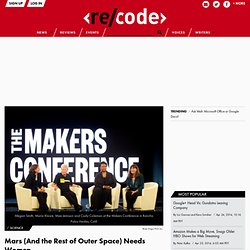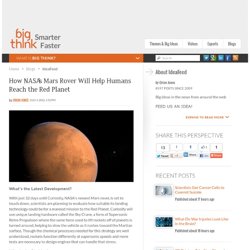

Musk: SpaceX Could Land Humans on Mars in 10 to 12 Years : Discovery News. SpaceX founder Elon Musk thinks his private spaceflight company will have the capability to land humans on Mars within 12 years, assuming the availability of funding for the historic mission.

Also, once SpaceX starts making steps toward this goal, the company could be floated on the stock market to boost investment for the Red Planet adventure. NEWS: Musk: SpaceX Making ‘Progress’ Toward Mars Colony Musk, who also founded the electric car manufacturer Tesla, has always made his interplanetary intentions known, but this recent announcement is a reminder about how far the company has come and how far it is looking into the future. During the CNBC interview, Musk said: “I’m hopeful that the first people could be taken to Mars in 10 to 12 years, I think it’s certainly possible for that to occur. But the thing that matters long term is to have a self-sustaining city on Mars, to make life multiplanetary.”
New Era: SpaceX Releases Booster Soft Splashdown Video. Meet Five People Who Signed Up for a One-Way Ticket to Mars. When nonprofit organization Mars One announced plans to build the first human settlement on Mars, over 200,000 people signed up to be on the first one-way flight.

In case you are wondering “What are they thinking?” This video glimpses into the lives of five of those volunteers, asking why they want to go and what, if anything, would change their minds. While my first inclination was to point and laugh about how crazy this is, I couldn’t help but be touched by a characteristic all five of these volunteers share: the desire to be a part of something bigger and to find their purpose in life. I hope they find what they’re looking for, whether it is through pioneering Mars (which would be pretty spectacular if it actually worked) or something a little more down to Earth.
If you’d like see the logistical plans for the Mars One mission (or, heck, even sign up yourself), visit the organization’s website for more information. H/T Vita Brevis Films. A blog of old times and new beginnings. Mars (And the Rest of Outer Space) Needs Women. Gwynne Shotwell, the president and COO of SpaceX, has one small request: America should spend more on tech and science education, for both boys and girls, than it does on beer.

“Spending on STEM (science, technology, engineering, mathematics) education in public education about equals what we spend on beer. Not beer and pizza. Not beer and wine. Beer,” Shotwell said on Tuesday, speaking onstage at the first Makers Conference in Rancho Palos Verdes, Calif. “I don’t think it’s a coincidence that we dropped five points in the last 15-year-olds’ math and science test.” As the number of young women studying in the overall STEM fields stays stubbornly low — and the quality of science education for both sexes seems to be falling — five leaders in space and tech came together to talk about the situation at the conference.
“I want to see my children go to Mars. “There’s a serendipity,” Smith said. “This thing about wanting to attract more women — it’s not rocket science. PIA16105_fig1.jpg (JPEG Image, 1463x978 pixels) - Scaled (68%) How NASA's Mars Rover Will Help Humans Reach the Red Planet. With just 32 days until Curiosity, NASA's newest Mars rover, is set to touch down, scientists are planning to evaluate how suitable its landing technology could be for a manned mission to the Red Planet.

Curiosity will use unique landing hardware called the Sky Crane, a form of Supersonic Retro Propulsion where the same force used to lift rockets off of planets is turned around, helping to slow the vehicle as it rushes toward the Martian surface. Though the chemical processes needed for this strategy are well understood, rockets function differently at supersonic speeds and more tests are necessary to design engines that can handle that stress. A meeting of the Lunar Planetary Institute convened last month to discuss other ways to land a craft on Mars, namely Hypersonic Inflatable Aerodynamic Decelerators (HIADs) and various forms of aerobraking.
Read it at Universe Today Related Content The Forgotten History of Project Orion Freeman Dyson Physicist and Writer. How NASA's Mars Rover Will Help Humans Reach the Red Planet.